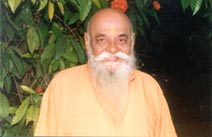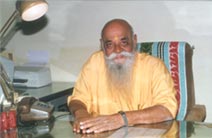The Man and His Mission |
The eyes have a youthful sparkle, though the
silvery white mane and flowing beard that frame his cherubic |
face give away his
age. At 77, Prof. N.S.Ramaswamy is a man with a mission. The welfare and care of
animals. He is the ‘Swaminathan’ of India’s livestock, promising to bring
about a revolution in livestock care and management. His vast experience in the field of
Management has seen him occupy posts as varied as the founder director of the Indian
Institute of Management, Bangalore to being Consultant cum-advisor to the Airport
Authority of India and the Parliamentary Committee on Railways. He was also Member of the
Review Committees on Reserve Bank of India, National Institute of Design and the Indian |

|
Statistical
Institute. What has been close to his heart all along has been his passion for the welfare
of animals. A passion that made him the Chairman of the Animal Welfare Board of India and
the Meat Committee of the Government of India. A passion that made him establish CARTMAN
an organization that fosters and promotes harmonious relationships between, man, animal
and nature. His greatest hurdle has been to convince an unrelenting Government to
modernise slaughter-houses. With the Jain community strongly against animal slaughter
along with the divinity accorded to the cow, the Government refuses to budge, not wanting
to antagonise its precious voters. But Prof.Ramaswamy is relentless in his campaign. A
modern Krishna for the bovine community, for which its divine status has proven to be its
greatest hurdle. Online Bangalore caught up with him at CARTMAN’s office in
Koramangala in an exclusive interview on his plans for alleviating the suffering of
India’s livestock
|
What is the history of animal welfare in India?
Unlike in the west where it is totally privately run, the Government of India supports
animal welfare. The British formed the SPCA almost 130 years ago. Of the 700 odd Animal
Welfare organizations in the country, only a 100 are active. This is mostly due to lack of
finance and professional competencies. Most of these organizations are restricted to the
welfare of cats and dogs and other pets..
|
What does the name CARTMAN signify?
The cart was the first technology of man, derived from his first invention, the wheel.
Whereas man, stands for management and man. I strongly believe that for the progress of
any society, technology and management are the two key factors. CARTMAN also stands for
art and the divinity within man.
|
You have focussed your attention mainly on the welfare of
livestock, why?
The suffering of cats and dogs are almost nothing, compared to that of the livestock in
India. The 80 million bullocks in India receive more than a crore beatings a day. They
suffer so much. One of the reasons is the barbaric slaughtering. 150 million large and
small animals and 400 million poultry birds are slaughtered every year in India to provide
6 million tons of meat. They are transported, and slaughtered in the most inhuman of
circumstances in the slaughter houses in the country of which only 3000 are legal while
over 30,000 are illegal.
|
How do you propose to improve conditions for livestock?
During my stint as Chairman of the Animal Welfare Board in 1991, I had proposed to the
Government a scheme to modernize the slaughter houses in order to both reduce the
suffering of the animals as well as the wastage. This was by means of introducing the
‘stunning’ method, whereby the animal is stunned to unconsciousness and then
killed without other animals watching. This method would also lead to cleaner
|

|
premises and better meat as the blood flows out better and
prevents toxins from forming due to stress. This method is presently used only by the
eleven odd bacon factories in India. Even in the 4 modern slaughter houses stunning is not
implemented. The proposal didn’t go down well with Meneka Gandhi, the minister in
charge of the Animal Welfare Board, who asked me to resign. She was under pressure from
the Jain community who were against animal slaughter. So I resigned and the project failed
to take off even though the Animal Welfare Board Act, which was passed by the parliament
clearly stated that the Board was to advise the government on methods to improve
conditions of slaughter.
|
|
You were also branded as Meatman at one time, why?
That was during my days as the Chairman of the Meat Committee of the government of India.
I proposed a new idea. Instead of transporting the animals, why not kill them at their
respective places and transport only the meat? Rural abattoirs could be built in these
places to slaughter the animals, thereby providing fresh employment and opportunity for
allied industries like tanning etc. using the skin, hoof, horn and bone. And in the
process, city abattoirs could be closed down, reducing pollution. This was when the Jains
opposed me again, calling me Meatman.
|
What is your third proposal on livestock care?
The fodder requirement of all the country’s livestock is 1000 million tons. The total
fodder production in the country is only 300 million tons, leaving a starvation gap of 700
million tons. The animals are starving and therefore unproductive, leaving the farmer with
lesser revenue. 8 million of them are slaughtered either because they can’t provide
milk or can’t work, due to lack of fodder. I have prepared a project on How to
increase Fodder, Feed and Nutrition for Animal Care. This project envisages the farming of
40 million hectares of the 140 million hectares of wasteland in the country to produce
fodder for the livestock and fill the starvation gap.
|
How is the funding for livestock projects?
That is the saddest part. Except for the 5million odd milch cows in co-operatives, the
Government has no funding or subsidies for livestock.
|
Let me give you an interesting comparison.
The asset value of all livestock today is Rs.100,000 crore. So is the annual crop
production in the country. Both are rural based and managed by farmers. But, while the
crop production gets a subsidy of Rs.25,000 crores, for the livestock there is not even a
single paise. Of the 150 million hectares of ploughed land in India, 100 million acres are
ploughed by animals, saving the country upto 12,000 crores in precious foreign exchange
for fuel.
|
What is presently on your agenda for livestock?
Along with the land, plough and the cart, the animal is also an instrument of
production.Increased production from livestock could help increase the revenue of the
farmers.
On the 30th of November, I’m presenting my paper on How to increase fodder, feed and
Nutrition for Animal careto the Planning commission. I have presented my papers before
them four times before. But I’m still going to try!
|
CARTMAN
870, 17-E Main
Koramangala 6th Block
Bangalore 560 095.
Ph: 553 0121/ 553 3020
e-mail: [email protected]
|
| By
Monu Surendran |
|
|
|
|
|